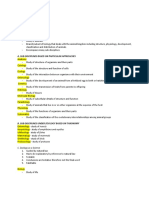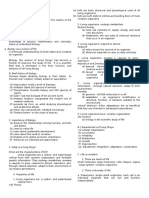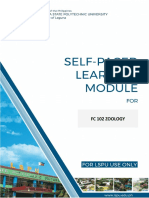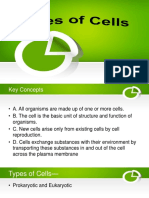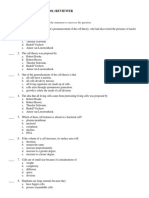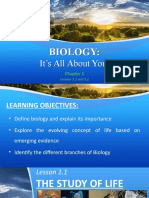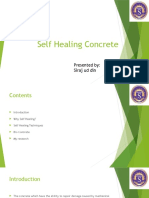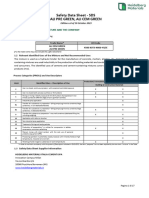General Biology Reviewer
General Biology Reviewer
Uploaded by
Angeli Maligalig RamirezCopyright:
Available Formats
General Biology Reviewer
General Biology Reviewer
Uploaded by
Angeli Maligalig RamirezOriginal Description:
Copyright
Available Formats
Share this document
Did you find this document useful?
Is this content inappropriate?
Copyright:
Available Formats
General Biology Reviewer
General Biology Reviewer
Uploaded by
Angeli Maligalig RamirezCopyright:
Available Formats
Life - a collection of complex but organized systems, all working together Lesson 1.
3 Biology as a Science
Science – is a body of systemized information about living things derived from observations and
Lesson 1.1 (The Study of Life) experiments.
Biology - the science of life; the study of life Two main approaches in scientific investigations:
- it deals with structures, functions, and relationships of organisms with their environment.
- Greek words: (1) bios, “life”; (2) logos, “study” 1. Discovery-based science
- 3 major divisions of the biological sciences: -relies mainly on verifiable observations and measurements
Microbiology - study of organisms 2. Hypothesis-based science
Botany - study of plants -involves the use of scientific method:
Zoology - study of animals i. Observation – identifying and clearly defining the problem
ii. Hypothesis – formulating a possible logical answer to the identified problem
Traditional Branches of Biological Sciences 3. Experiment
-conducting controlled attempts to test one or more hypotheses and includes
Taxonomy – study of naming and classifying organisms recording and analyzing results
Cytology – study of structures and functions of cells 4. Conclusion
Embryology – study of formation and development of organisms -formulating generalization about the results that may accept, reject or modify the
Anatomy – study of structures and parts of organisms hypothesis
Physiology – study of functions of living organisms and their parts
Biochemistry – study of biochemical compositions and processes of living things Two kinds of reasoning
Genetics – study of heredity and variation
Evolution – study of origin and differentiation of various organisms Inductive reasoning – scientific reasoning from specific to general
Ecology – study of relationships of organisms with each other and their environment Deductive reasoning – scientific reasoning from general to specific
Immunology – study of immune system
Theories – existing body of knowledge; which explains the natural world and are well-accepted by the
Morphology – study of forms and structures of organisms
scientific community
Modern Branches of Biological Science -- Common Biological Theories:
Cell Theory – Cell is the basic unit of life. All organisms are composed of cells. All
Bioinformatics – study of biological data using computer programs cells come from preexisting cells.
Genomics – study of the entire genetic material of an organism Gene Theory – Inherited information dictates the structure, function, and behavior of
Molecular biology – study of molecules that make up the cells of living organisms organisms.
Pharmacogenomics- study of how genes affect a person’s response to drugs Theory of evolution by natural selection – Organisms possess inherited traits that may
Proteomics – study of the different proteins in an organism make them adaptable to changing conditions in their environment
Synthetic Biology – study of combined biology and engineering
Systems Biology – study of systems of biological molecules such as cell, organism or species Lesson 1.4 (Life and its Beginnings)
Early Beliefs about the Origin of Life
Lesson 1.2 (Importance of Studying Biology)
Abiogenesis – theory of spontaneous generation (the idea that life originates from nonliving
*Biology can help solve the societal problems matter).
*Biology is important because it is a science that helps you think critically, make informed choices, and -- proposed by Aristotle in the 4th century
solve problems Biogenesis – life originates from preexisting life
*It explains our similarities and differences with other organisms i. Francesco Redi’s Experiment (using jar, gauze and meat)
*It helps us understand the functions and reactions of our body ii. John Needham’s Experiment (he supports the abiogenesis)
*It helps us in understanding how these life forms survive, respond, and interact in their environment iii. Lazzaro Spallanzani’s Experiment (rejects the abiogenesis of Needham)
since they play essential roles to keep the balance in the environment iv. Louis Pasteur’s Experiment (disproves the abiogenesis)
*By studying the life processes of different causative agents of diseases, their reaction to chemicals, -it is the most acceptable experiment and convinced the scientists that
people might learn ways to fight and prevent the spread of diseases. abiogenesis does not occur
Current Beliefs about the Origin of Life Accretion – the growth that happen to non-living things by external
addition of substances
Divine Creation – creationism Development – the process of undergoing in different stages of a
Spontaneous Origin – lightning or other geothermal energy culminated in the evolution of cells life cycle
from simple to multicellular forms (Miller-Urey experiment) Reproduction – is a process by which genetic information is passed on from
Panspermia – a meteor or cosmic dust may have carried to Earth significant amounts of one generation to another as organisms produce offspring
organic molecules, which started the evolution of life Sexual reproduction – two parents are involved by the union of their
sex cells to produce a unique individual of their kind
Lesson 1.5 (Unifying Themes about Life) Asexual reproduction – occurs when an organism makes copies of
itself, as commonly found in lower life forms
Common Characteristics of Ling Living Things: Heredity: Unity Amidst Diversity
DNA is the molecule similar to all living organisms and responsible
Gathering and Using Energy for differences
In order to perform vital activities such as growth, movement, and reproduction, all Living and Interacting
living things require energy Organization of Life in Vertical Dimension – spreads the scope in terms of
Photosynthesis- where plants obtain energy from sunlight size scale from the microscopic DNA inside cells to the macroscopic view of
Cellular Respiration – energy is released by the breakdown of food substances the living sphere of the world, the biosphere.
Carbohydrates to glucose The Hierarchical Levels of Biological Organization:
Proteins to amino acids 1. Atoms
Metabolism – sum of all chemical processes and energy changes happening inside 2. Molecules
the body of an organism 3. Organelles
Nutrient Uptake and Processing 4. Cells
Nutrition – the process by which organisms acquire food 5. Tissue
Maintaining Internal Balance 6. Organs
Excretion – the process of removing wastes 7. Organ system
Homeostasis – the maintenance of the body’s internal environment 8. Organism
Enzymes – at metabolic level, help regulate the rate at which these reactions 9. Population – a group of the same kind of organisms living
occur, eg. The amt. of nutrients to be processed into other forms. in an area
Hormones – at organismal level, these are regulatory chemicals that control 10. Community – different populations sharing the same
the functions of activities, growth, and development habitat
Responding, Adapting, and Evolving 11. Ecosystem – communities exist in an environment affected
Motility – it is the movement or locomotion of a living thing by both living and nonliving components
Irritability – it is the sensibility or the ability of an organism to respond appropriately to 12. Biome - a community of plants and animals that have
a stimulus common characteristics for the environment they exist in
Tropism or response – the reaction of an organism to stimuli 13. Biosphere – all ecosystems on earth
Stimuli – external factors such as light, sound, temp., pressure, food Organization of Life in Horizontal Dimension – to show the diversity and
sources, or presence of chemical substances; these affect living things richness of organisms inhabiting our planet
Individual Adaptation – the ability to adjust to changes in the environment; it usually The 6 kingdoms of the living world divided into 3 domains of life:
happens more slowly than responding to a stimulus because some changes need to 1. Domain Bacteria (prokaryotes)
occur in the organism (days) Bacteria
Evolutionary Adaptation – changes in the characteristics of a group of organisms 2. Domain Archaea (prokaryotes)
(species) over time Archaea
Reproducing and Continuing Life 3. Domain Eukarya (eukaryotes)
Growth and Development Protista, Plantae, Fungi, Animalia
Growth – is an increase in size, and volume by converting food to become a Prokaryote - a microscopic single-celled organism that has neither a distinct
part of body cells nucleus with a membrane nor other specialized organelles
Intussusception – the process of growth within the cells Eukaryote - are organisms whose cells have a nucleus enclosed within
Organogenesis – formation of new organs membranes
Lesson 2.2 (The Cell and Its Beginning) 7. Scanning electron microscope – used to examine 3D surface structures or shapes of
objects such as viruses
Earliest Microscopic Observations 8. Fluorescent microscope – illuminates objects stained with fluorescent dyes that glow
in the dark.
Robert Hooke - he compared the cells he saw in cork to the small rooms that monks lived in
9. Confocal scanning microscope – used to examine 3D structure of a cell or organelle
and called those porous structures as cellulae, Latin word for a “small room”
without cutting the specimen into sections.
Micrographia – a manuscript that is a collection of the works and drawing Hooke
Video microscopy – the process by which objects examined using the different microscopes
using his microscope
can be photographed or viewed on TV or computer screens.
Antonie van Leeuwenhoek – was credited to be the first to study magnified cells
-- he was the first to observe living cells
animalcules, “Latin word for “little animals”
Lesson 2.3 (Basic Cell types)
The Cell Theory
Similar Structural Parts of Living Things
1. All organisms are composed of one or more cells.
2. Cells are the smallest and basic units of structure and function in organisms. 1. Cell Membrane or Plasma Membrane – the outer boundary that regulates the passage of
3. Cells arise only from previously existing cells. materials into and out of the cell
2. Cytoplasm – a gel-like substance making up the cell’s internal environment
Matthias Jakob Schleiden – focused his interests in the study of plant cells 3. Genetic material – DNA and RNA; (DNA) provide instructions to make proteins, regulates
Theodore Schwann – examined animal cells activities, and enables cells to reproduce
Rudolf Carl Virchow – all cells come from other cells through the process of cell division 4. Ribosomes
The Origin of Life (Hypothesis): Organic Chemical Evolution 5. Cytoskeleton – microscopic fibers where organelles can be found
Life originated as primitive cells (protocells) from inorganic and organic molecules in
Earth’s prebiotic oceans some 3.5 to 4 billion years ago. Two Types of Cells
Aleksandr Oparin - notable for his contributions to the theory of the origin of life on
The presence of a specific type of cell allows biologists to classify organisms based on their
Earth, and particularly for the “primordial soup” theory of the evolution of life from
complexity.
carbon-based molecules.
Stanley Miller - performed an experiment that may explain what occurred on primitive
1. Simple prokaryotes
Earth billions of years ago supporting Oparin’s hypothesis
- pro meaning “before” and karyon meaning “nut”, which all mean “before the nut”
Protocells – are hypothesized to have been formed by the polymerization of organic
- first kind of cell to develop
molecules in heated rocks in clay.
- simple organisms possessing cells that are smaller in size with simple internal
Lesson 2.2 (Lens of a Microscope) structures
- they reproduce very fast; thus, they can exist in great nos. in air, bodies of water,
Micrograph – the image produced by a microscope soil, and even inside bodies of living hosts
Magnification – is the measure of optical instruments for an object to appear larger than its - two major kinds of prokaryotes:
actual size Bacteria (singular "bacterium")
Resolution – indicates clarity of an image Archaea (singular "archaeon")
Different types of microscope: 2. Complex eukaryotes
1. Light microscope – allowed man to see cells but with limited complexity - eu meaning “true” and karyon meaning “nut”
2. Electron microscope – enabling man to see the intricacies of the cell and its parts - larger in size and more complex structural components
3. Compound microscope – used to examine cells and sections of tissues with the use - fungi, plants, animals, and protists
of sunlight or artificial light to illuminate an object being examined - have their genetic material (DNA) encased within a distinct nucleus
4. Stereomicroscope – used to examine the external structures of a specimen such as - have many membrane-bound interior compartments and their organelles are neatly
insects. arranged
5. Phase-contrast microscope – is used to examine highly transparent objects such as
unstained cells.
6. Transmission electron microscope – used to study internal structures of cells through
sectioned specimens.
You might also like
- General Biology 1 NOTES PDFDocument18 pagesGeneral Biology 1 NOTES PDFRose Mendizabal84% (32)
- Chemistry Reviewer PDFDocument10 pagesChemistry Reviewer PDFJom-Jom Fong Ronquillo75% (8)
- Cambridge Checkpoint Science Workbook 8 PDFDocument16 pagesCambridge Checkpoint Science Workbook 8 PDFdil afroza karim Lina57% (37)
- Biology Reviewer Grade 12 STEM First SemesterDocument8 pagesBiology Reviewer Grade 12 STEM First SemesterEfren Lucero100% (5)
- General Chemistry ReviewerDocument54 pagesGeneral Chemistry ReviewerJohn Eivhon Festijo0% (2)
- General Chemistry Notes For SHS PDFDocument20 pagesGeneral Chemistry Notes For SHS PDFAlwyn Dave Ambatali100% (7)
- General Biology ReviewerDocument4 pagesGeneral Biology ReviewerJm Gutierrez63% (8)
- General Biology 1Document190 pagesGeneral Biology 1Osannah Irish90% (10)
- General Science ReviewerDocument1 pageGeneral Science ReviewerTin Acidre0% (1)
- Reviewer in ChemistryDocument8 pagesReviewer in ChemistryChristineManrique91% (11)
- Chemistry 9th Fbise PDFDocument211 pagesChemistry 9th Fbise PDFtala khole57% (7)
- Reviewer in General ZoologyDocument12 pagesReviewer in General ZoologyJasmine Fritz Cabrera100% (1)
- Introduction To ZoologyDocument7 pagesIntroduction To ZoologyMs. Wren100% (2)
- Zoology Lecture NotesDocument5 pagesZoology Lecture NotesRamea Lamano100% (3)
- Cell Structure and Function ReviewerDocument4 pagesCell Structure and Function ReviewerLeandre Jasmine Reyes100% (3)
- Botany Reviewer For First Quarter PDFDocument6 pagesBotany Reviewer For First Quarter PDFDale Maristela Peñalosa100% (3)
- Chemistry Nmat ReviewerDocument8 pagesChemistry Nmat ReviewerAlec Jasper U. Villamayor100% (7)
- Workplace Site Audit Checklist PharmacyDocument3 pagesWorkplace Site Audit Checklist PharmacyWaqar LatifNo ratings yet
- Specification For PVC Door & UPVC - WindowDocument16 pagesSpecification For PVC Door & UPVC - Windowsurbhi aggarwalNo ratings yet
- Review Problems For 3rd LE (Mass Transfer Problems)Document2 pagesReview Problems For 3rd LE (Mass Transfer Problems)Julie Anne del RosarioNo ratings yet
- Biology Reviewer: Functions, and Relationships of Living ThingsDocument4 pagesBiology Reviewer: Functions, and Relationships of Living ThingsAriane CloresNo ratings yet
- Genbio Reviewer 1Document8 pagesGenbio Reviewer 1Franchezkka Mae Belaro100% (1)
- Biology Reviewer (LT#1 2) PDFDocument9 pagesBiology Reviewer (LT#1 2) PDFEvernim OmpacanNo ratings yet
- Biology ReviewerDocument9 pagesBiology Reviewerflay1618100% (3)
- Genbio 1 1ST Grading ReviewerDocument11 pagesGenbio 1 1ST Grading ReviewerTodo Roki100% (1)
- General Biology ReviewerDocument4 pagesGeneral Biology ReviewerJes NapiñasNo ratings yet
- Grade 11 Biology ReviewerDocument5 pagesGrade 11 Biology ReviewerVen ReyNo ratings yet
- Reviewer in General Biology Ii - KmbsDocument5 pagesReviewer in General Biology Ii - KmbsKSNo ratings yet
- Cell ModificationDocument2 pagesCell ModificationLovelle Jade RuizNo ratings yet
- Branches of BiologyDocument3 pagesBranches of BiologyVheronica100% (2)
- Physics Finals ReviewerDocument13 pagesPhysics Finals ReviewerDanielle Clarice ReyesNo ratings yet
- Zoology Module 1Document10 pagesZoology Module 1Vanessa R. Paje100% (1)
- Geology ReviewerDocument12 pagesGeology ReviewerGrace MagbooNo ratings yet
- General Biology QuizDocument2 pagesGeneral Biology QuizQueng Eledia100% (2)
- Biology Reviewer 2021Document8 pagesBiology Reviewer 2021Keano Gelmo100% (1)
- General ZoologyDocument14 pagesGeneral ZoologyMatthew Gabales100% (1)
- Diagnostic Test in General Biology IDocument6 pagesDiagnostic Test in General Biology ISamantha Rulla100% (1)
- Mechanisms That Produce Change in PopulationsDocument44 pagesMechanisms That Produce Change in PopulationsEvangelene Esquillo Sana100% (1)
- Biology 1st DiscussionDocument52 pagesBiology 1st DiscussionBea BulasaNo ratings yet
- Earth Science ReviewerDocument2 pagesEarth Science ReviewerMaestro Pisika Lpt100% (2)
- Cell Types & Cell ModificationDocument41 pagesCell Types & Cell ModificationShane Marcande Calicdan74% (19)
- Cell Theory Timeline: DirectionsDocument5 pagesCell Theory Timeline: DirectionsBoom Boom100% (1)
- Physics ReviewerDocument8 pagesPhysics ReviewerLucky MantibeNo ratings yet
- Cellular Division Reviewer PDFDocument16 pagesCellular Division Reviewer PDFBrylle Angelo PolintanNo ratings yet
- Organismal BiologyDocument30 pagesOrganismal BiologyLeamonique Ajoc100% (1)
- Biology Reviewer NotesDocument26 pagesBiology Reviewer Notesfkrugga11No ratings yet
- Reviewer in BiologyDocument13 pagesReviewer in BiologyAldren BeliberNo ratings yet
- Biology Test With TOSDocument4 pagesBiology Test With TOSRaymund Platilla100% (3)
- General Biology 1 (BIO01) Reviewer 2017Document30 pagesGeneral Biology 1 (BIO01) Reviewer 2017Adonis AdornadoNo ratings yet
- General Biology Midterm Exam: Chapter 1: Introduction - Themes in The Study of LifeDocument4 pagesGeneral Biology Midterm Exam: Chapter 1: Introduction - Themes in The Study of LifeNermaDžaferovićNo ratings yet
- Reviewer in MicrobiologyDocument5 pagesReviewer in MicrobiologyLuzNo ratings yet
- General Zoology (Laboratory)Document20 pagesGeneral Zoology (Laboratory)Pamela Santos100% (1)
- General Biology 1 ReviewerDocument3 pagesGeneral Biology 1 ReviewerJames SorianoNo ratings yet
- Plant & Animal TissueDocument39 pagesPlant & Animal TissuePrincess Erbie Austria100% (2)
- GenBio ReviewerDocument8 pagesGenBio ReviewerMarxel AbogadoNo ratings yet
- Chemistry ReviewerDocument9 pagesChemistry ReviewerKeishaAaliyahNo ratings yet
- Gen Bio Periodic TestDocument7 pagesGen Bio Periodic TestRestyness Farochilin Tambo-ong33% (3)
- Evolution and Origin of BiodiversityDocument13 pagesEvolution and Origin of Biodiversitykharry8davidNo ratings yet
- Science ReviewerDocument5 pagesScience Reviewercha_lejanoNo ratings yet
- Reviewer Biosci1-4Document24 pagesReviewer Biosci1-4Cyriz Matthew MontesNo ratings yet
- Chapter 1 Introduction To Biology Lesson 1.1 and 1.7Document140 pagesChapter 1 Introduction To Biology Lesson 1.1 and 1.7Zetroc Jess100% (1)
- Biology: Biology Deals With The Study of andDocument3 pagesBiology: Biology Deals With The Study of andMariel CuaresNo ratings yet
- Genbio Week 1 Handout 1Document37 pagesGenbio Week 1 Handout 1norpower23No ratings yet
- Biology: I. Define Biology and Its BranchesDocument11 pagesBiology: I. Define Biology and Its Branchesanon_381785486No ratings yet
- Gen Bio DorayDocument3 pagesGen Bio DorayNate Dela VegaNo ratings yet
- How To Play Safe HoliDocument3 pagesHow To Play Safe HoliShubh ParmarNo ratings yet
- A UricDocument8 pagesA UricmichelNo ratings yet
- Chemistry Module V Organic Chemistry II PDFDocument313 pagesChemistry Module V Organic Chemistry II PDFdebasij86% (7)
- 2-1 2-2 AsepticProcessingDocument47 pages2-1 2-2 AsepticProcessingChristopher Sexton100% (1)
- PVC TopicDocument5 pagesPVC TopicMarnel Roy MayorNo ratings yet
- Stella-Aerosol - WD Spray - MSDSDocument4 pagesStella-Aerosol - WD Spray - MSDSseitoikeshi9No ratings yet
- Turbine:: Working PrincipleDocument11 pagesTurbine:: Working PrincipleAzan khanNo ratings yet
- Understanding Refractory Failures in Fired Heaters White PaperDocument10 pagesUnderstanding Refractory Failures in Fired Heaters White PaperVAHIDNo ratings yet
- N E A P S9: Onclinical Valuation For Nticancer HarmaceuticalsDocument13 pagesN E A P S9: Onclinical Valuation For Nticancer HarmaceuticalsMariela Elizabeth Carmen ZenónNo ratings yet
- +1 Chemistry - Most Important Questions & Answers 2024-CHAPTER-1-9Document43 pages+1 Chemistry - Most Important Questions & Answers 2024-CHAPTER-1-9Arun V nathNo ratings yet
- ELINC INVENTORYreqno - jrc52455Document244 pagesELINC INVENTORYreqno - jrc52455Alberto GiudiciNo ratings yet
- Arc WLDG Basic Workshop Practice 04092018Document2 pagesArc WLDG Basic Workshop Practice 04092018Abraiz NajamNo ratings yet
- Art 2 PDFDocument10 pagesArt 2 PDFJairArmandoGomezPerezNo ratings yet
- Mechanics-2 2 Axial LoadingDocument22 pagesMechanics-2 2 Axial LoadingMuhd NizammudinNo ratings yet
- Company ProfileDocument7 pagesCompany ProfileNITHINNo ratings yet
- Ferdi CVDocument6 pagesFerdi CVFerdinand SiahaanNo ratings yet
- Agarbatti Show ListDocument22 pagesAgarbatti Show ListPriyanka KadamNo ratings yet
- Integrated Science Grade 7 NotesDocument75 pagesIntegrated Science Grade 7 Noteswww.simokumuNo ratings yet
- Api 602Document52 pagesApi 602SERGIO CELIS ARIZANo ratings yet
- 1 s2.0 S0039914017305982 MainDocument10 pages1 s2.0 S0039914017305982 MainMahmoud El-NoubyNo ratings yet
- Self Healing ConcreteDocument17 pagesSelf Healing ConcreteSirajUdDinNo ratings yet
- Italcementi - Ali Pre and Ali Cem - SDSDocument17 pagesItalcementi - Ali Pre and Ali Cem - SDSsumeshNo ratings yet
- MIUX529C: Military SpecificationDocument17 pagesMIUX529C: Military SpecificationJhan Carlos RamosNo ratings yet
- ASSIGNMENT NotesDocument10 pagesASSIGNMENT Notesnm.ananya2008No ratings yet
- Amphenol Solutions GuideDocument374 pagesAmphenol Solutions Guidejovares2099100% (1)













